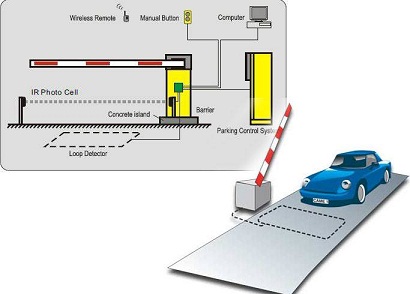
YOUR GATE’S EYE TO SEE YOUR CAR

Loop detectors are used to detect the presence of vehicles. Typically the loop is connected to a loop detector. Some gate operators have built in sockets to accept loop detectors and some models require the detector to be wired in. Loop Detector Exit loops are used to open gates to allow a vehicle's exit. Safety loops are used to prevent a gate from closing on a vehicle. Two loops can be wired to one detector. This is frequently the case in safety loops. Loops are placed in front and behind the gate.
Shadow Loops are typically used in commercial locations. A Shadow Loop keeps the gate open while a vehicle is above it, just like a safety loop, but only functions when the gate is in the full open position. Preformed Loops are placed below the surface prior to laying asphalt or pouring concrete. They are available in several sizes depending on driveway width.
Car Loop Detectors are used to detect the presence of a vehicle to open a gate, or as a safety device to prevent the gate from closing on a vehicle in its path. Available with two types of connectivity; plug-in and wire harness. Direct Plug-In Loop Detectors are designed for specific control boards while the Wire Harness or Mountable Socket is universal fit. Loop detectors are available as Direct Burial or Cut-In. In general, Direct Burial Loops are placed below the surface prior to application of asphalt or concrete while Cut-In Loops are installed within a slot sawed into the existing surface. Probe Style Vehicle Sensors are self-contained units including a loop detector and sensing probe or wand. This type of vehicle motion detector is easy to install however, it is not recommended as a safety loop. 
An insulated, electrically conducting loop is installed in the pavement. The electronics unit transmits energy into the wire loops at frequencies between 10 kHz to 200 kHz, depending on the model. The inductive-loop system behaves as a tuned electrical circuit in which the loop wire and lead-in cable are the inductive elements. When a vehicle passes over the loop or is stopped within the loop, the vehicle induces eddy currents in the wire loops, which decrease their inductance. The decreased inductance actuates the electronics unit output relay or solid-state optically isolated output, which sends a pulse to the traffic signal controller signifying the passage or presence of a vehicle. Parking structures for automobiles may use inductive loops to track traffic in and out or may be used by access gates or ticketing systems to detect vehicles while others use Parking guidance and information systems.
Functions of Car Detectors:
Don’t think so much! Invest your money in something that will benefit you and your family. Order a
car loop detector today and stay safe inside the vehicle in bad weathers!
|

